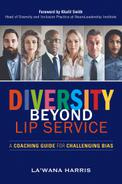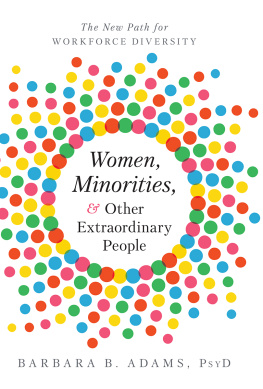

This publication is designed to provide accurate and authoritative information regarding the subject matter covered. It is sold with the understanding that neither the publisher nor the authors are engaged in rendering legal or other professional service. If legal advice or other expert assistance is required, the services of a competent, licensed professional should be sought. The federal and state laws discussed in this book are subject to frequent revision and interpretation by amendments or judicial revisions that may significantly affect employer or employee rights and obligations. Readers are encouraged to seek legal counsel regarding specific policies and practices in their organizations.
This book is published by the Society for Human Resource Management (SHRM). The interpretations, conclusions, and recommendations in this book are those of the authors and do not necessarily represent those of the publishers. This manuscript conforms to AP style. As such, wording and terminology for racial classifications use the descriptors black and white rather than African American or Caucasian.
Copyright 2010 Society for Human Resource Management. All rights reserved.
This publication may not be reproduced, stored in a retrieval system, or transmitted in whole or in part, in any form or by any means, electronic, mechanical, photocopying, recording, or otherwise, without the prior written permission of the Society for Human Resource Management, 1800 Duke Street, Alexandria, VA 22314.
The Society for Human Resource Management (SHRM) is the worlds largest association devoted to human resource management. Representing more than 250,000 members in over 140 countries, the Society serves the needs of HR professionals and advances the interests of the HR profession. Founded in 1948, SHRM has more than 575 affiliated chapters within the United States and subsidiary offices in China and India. Visit SHRM Online at www.shrm.org.
Interior and Cover Design: Blair Wright
Library of Congress Cataloging-in-Publication Data
Dominguez, Cari M., 1949
Leading with your heart : diversity and ganas for inspired inclusion / Cari M. Dominguez, Jude Sotherlund.
p. cm.
Includes bibliographical references and index.
ISBN 978-1-58644-153-1
1. Diversity in the workplace. 2. Leadership. 3. Personnel management. I. Sotherlund, Jude. II. Society for Human Resource Management (U.S.) III. Title.
HF5549.5.M5D66 2009
658.4092--dc22
2009040392
10 9 8 7 6 5 4 3 2 1 09-0285
Contents
Acknowledgments
This book is the product of many years of conversations we have had in our quest to foster fairness in the workplace while furthering the goals of diversity and inclusion. Having worked closely together 20 years ago in the creation and implementation of the U.S. Department of Labors Glass Ceiling Initiative and having remained engaged in this quest ever since through various high-profile appointments and assignments, we concluded that there were lessons learned and a message to be shared, a message rather simple in concept, yet difficult in its application.
It is our hope that in this book you will find what we believe is the essence of what drives results and moves us closer to the final destination of a truly diverse and inclusive workplace: leading with the convictions of your heart. It is the coupling of a keen business sense and functional expertise with the sincerest qualities of the heart integrity, empathy, and compassion that will lead to the desired results. For some, it might mean going it alone for a while, and we applaud you. For those whose efforts have been more a series of stops and starts, we encourage you to glean the best of each practice, refine and retool.
We greatly appreciated the support and assistance of all who made this book possible: the dozens and dozens of individuals whose work experiences were shared with us; the companies and leaders who provided examples of heartfelt leadership, and the organizations whose research and findings served to further inform our work.
We are particularly indebted to SHRM for enabling this book to come to fruition. To Christopher Anzalone, book publishing manager, who was with us every step of the way, providing invaluable guidance and counsel; to the SHRM readers: Lewis J. Benavides, Texas Womens University; K. Joy Chin, Jackson Lewis LLP; and Shaunice Hawkins, Evolutions Consulting, who offered feedback and suggestions that served to enhance the quality of the manuscript; to Gary Rubin, chief publishing and e-media officer and group publisher for SHRM, who, along with members of the editorial board, buoyed our spirits with their vote of confidence for this effort; and to all others who took part in the publishing, marketing, and distribution of this book, we are forever grateful.
Finally, we want to thank each other. Just as it did over 20 years ago, our collaboration served to strengthen our friendship and mutual professional respect. Two heads were clearly better than one, as we complemented each other in style, focus, and points of view. To our families Bert, Jason, and Adam Dominguez and Dana, Emily, and Nicholas Sotherlund thank you for your encouragement, patience, and selfless support. Any undertaking of this nature takes precious time. We can only hope that this investment of time and effort will inspire many, many others to lead with their hearts, leaving behind attitudinal barriers and assumptions of the past. Our new generation of workers is deserving of it.
Preface
Long before there were affinity groups, employment councils, and workforce diversity banding with scorecards, there were indicators of a changing workplace. Employers saw it first-hand, and studies presaged the fact that our workforce was aging, needing more technologically advanced skills, and becoming increasingly supplied with immigrants from all over the world. Anticipating these trends while operating in a global economy, employers began to plan for this new workforce this more diverse workforce, different from anything ever seen before. But while most employers understood and satisfied their prescribed legal requirements to promote equal opportunity and ensure nondiscrimination in the workplace, the concept of diversity offered no such blueprint. And so the task of defining diversity and defending its business value fell upon each organizational leader.
Today, without a legal compliance mandate on diversity, there is still much variance as to how it is practiced, why it is important, and how much of a resource investment it should require. For those leaders who adopted diversity practices and made them an integral part of their organizational culture, their aha! moment came when they saw results; when diversity equaled profitability and sustainable success through greater workforce engagement. For those leaders, diversity became part of their culture of inclusion, which means accepting, valuing, and engaging everyone. Everyone had an opportunity to succeed. The business case for diversity is no different than the people case for diversity they are one and the same. Simply put, open and unfettered access to all available human talent is the best way to find the best talent. And top talent produces top results. A trajectory that began with legal mandates for nondiscrimination and affirmative action has evolved into the recognition that talent cannot be drawn from just a select few groups, but rather expanded to envelop the richness of backgrounds, qualities, abilities, and experiences that every aspiring individual has to offer regardless of personal characteristics. A commitment to diversity and inclusion extends beyond legal constraints by proactively seeking such talent and opening all opportunities to them.
Next page






